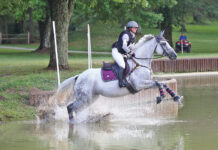 |
| Holly and Dexter showing in March 2011. Photo: Tom Werner |
For a long while, I’ve been interested in learning to scribe for a dressage judge. As a rider who competes, I spend long hours pouring over the scores and comments on my tests, so what could be better than sitting with the judge as she evaluates dozens of riders right in front of you?
I ended up scribing the Novice level test, the one I am currently doing in competitions, so it was even more interesting. The judge I scribed for was a very experienced dressage trainer, and I learned tons just by listening to her comments for each horse. Here are some of the things I came away with:
- Forward, forward forward. All other things being equal, a more forward horse will score higher. As my judge put it, “They should be booking it at this level!” It makes sense, since Novice horses aren’t asked for collection, so going too slow is likely to mean dragging along on the forehand.
- Steady Eddie: Speeding up and slowing down within a gait is a definite no-no at this level as well. Don’t try to extend the trot across the diagonal, just stay steady as a rock in your horse’s working gaits.
- A good walk is born that way: The only movement in the Novice test with a coefficient of 2 is the free walk. One gorgeous-walking got a 9, and as she put it, “That’s like getting two 9’s! You can’t teach them to walk like that—they have to be born with it. Some horses will never have better than a 5 or a 6 walk.” That said, you can always improve your horse’s walk score to the best it can be by going forward, showing overstride, and preferably a bit of downward stretch in the neck.
- A fussy head is the kiss of death. Some horses, whether they were just green or having a bad day, continually tossed their heads throughout most of the movements. These horses received the worst scores—worse than horses with short strides, horses that were too overflexed (behind the bit), et cetera. If your horse is fussing with his head, get his teeth checked and re-evaluate your training program back to square one.
- Keep your rein contact steady. Nothing seemed to bother my judge more than “baggy/tight” reins. “You need a consistent line of communication to your horse, or he won’t know what you’re asking of him,” she said. You can soften with your inside rein to praise your horse, but he must always know what you want to do if he’s going to do it!
- Don’t cut corners—literally. Your score will probably be 1 point lower than it would otherwise if you cut off a corner. Go as deep as your horse will let you to really show the judge that you understand the geometry of the test.
- Rack up points on the centerline. Since you’re going toward the judge at C, all she can see is whether your horse is carrying his body straight. Ride that line straight as an arrow, and you’ll probably get a nice 8!
I hope these tips help anyone who rides or competes in dressage (or eventing). I was truly grateful for the opportunity to scribe, and had a blast learning so much. I can’t wait to do it again!
Back to The Near Side





VERY well written and good solid advice straight from the horse’s, er, judge’s mouth.
Loved this article. I guess scribing is kinda like getting a free lesson from the judge.